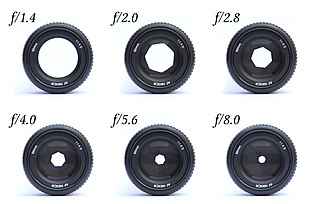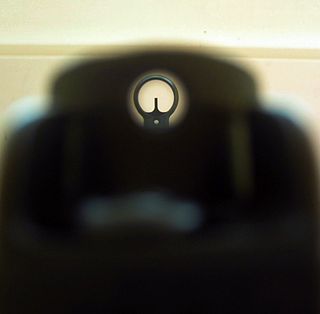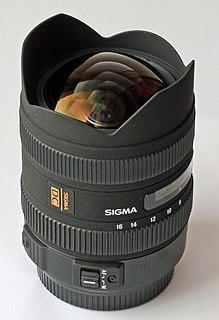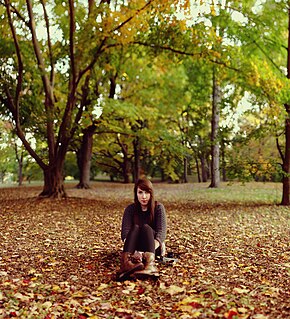
In optics, the numerical aperture (NA) of an optical system is a dimensionless number that characterizes the range of angles over which the system can accept or emit light. By incorporating index of refraction in its definition, NA has the property that it is constant for a beam as it goes from one material to another, provided there is no refractive power at the interface. The exact definition of the term varies slightly between different areas of optics. Numerical aperture is commonly used in microscopy to describe the acceptance cone of an objective, and in fiber optics, in which it describes the range of angles within which light that is incident on the fiber will be transmitted along it.

In optics, an aperture is a hole or an opening through which light travels. More specifically, the aperture and focal length of an optical system determine the cone angle of a bundle of rays that come to a focus in the image plane.

A camera lens is an optical lens or assembly of lenses used in conjunction with a camera body and mechanism to make images of objects either on photographic film or on other media capable of storing an image chemically or electronically.
Angular resolution or spatial resolution describes the ability of any image-forming device such as an optical or radio telescope, a microscope, a camera, or an eye, to distinguish small details of an object, thereby making it a major determinant of image resolution. In physics and geosciences, the term spatial resolution refers to the precision of a measurement with respect to space.

Iron sights are a system of shaped alignment markers used as a sighting device to assist in the aiming of a device such as a firearm, crossbow, or telescope, and exclude the use of optics as in reflector (reflex) sights, holographic sights, and telescopic sights.

The aperture is an opening in certain kinds of mollusc shells: it is the main opening of the shell, where the head-foot part of the body of the animal emerges for locomotion, feeding, etc.

A Coulter counter is an apparatus for counting and sizing particles suspended in electrolytes. It is used for cells, bacteria, prokaryotic cells and virus particles.
PENTAX *ist DS is a digital SLR camera produced by Pentax. The *ist DS produces a 6.1 megapixel resolution image. The *ist DS was a lower-prices follow-on to the Pentax *ist D. In September 2005 the Digital Imaging Websites Association (DIWA), a worldwide organization of collaborating websites, announced that Pentax had received their first DIWA Award for a DSLR camera. The *ist DS model was awarded with a Silver medal for outstanding test results.

Portal is a puzzle-platform video game developed and published by Valve Corporation. It was released in a bundle package called The Orange Box for Microsoft Windows, Xbox 360 and PlayStation 3 in 2007. The game has since been ported to other systems, including OS X, Linux, and Android.

The Pentax K10D and similar Samsung GX-10 are 10.2 megapixel digital single-lens reflex cameras launched in late 2006. They were developed in a collaboration between Pentax of Japan and Samsung of South Korea.

Seashore wildlife habitats exist from the Tropics to the Arctic and Antarctic. Seashores and beaches provide varied habitats in different parts of the world, and even within the same beach. Phytoplankton is at the bottom of some food chains, while zooplankton and other organisms eat phytoplankton. Kelp is also autotrophic and at the bottom of many food chains. Coastal areas are stressed through rapid changes, for example due to tides.

In the shell of gastropod mollusks, the lip is the free margin of the peristome or aperture of the gastropod shell.

The Sigma 8–16mm lens is an enthusiast-level, ultra wide-angle rectilinear zoom lens made by Sigma Corporation specifically for use with APS-C small format digital SLRs. It is the first ultrawide rectilinear zoom lens with a minimum focal length of 8 mm, designed specifically for APS-C size image sensors. The lens was introduced at the February 2010 Photo Marketing Association International Convention and Trade Show. At its release it was the widest viewing angle focal length available commercially for APS-C cameras. It is part of Sigma's DC line of lenses, meaning it was designed to have an image circle tailored to work with APS-C format cameras. The lens has a constant length regardless of optical zoom and focus with inner lens tube elements responding to these parameters. The lens has hypersonic zoom autofocus.
The Sony Cyber-shot DSC-RX1 is a premium fixed-lens compact camera made by Sony as part of its Cyber-shot line of digital cameras. The DSC-RX1 is notable for being the world's first fixed-lens, full-frame digital compact camera, and as of its announcement, it is the world's smallest full-frame digital camera but is also considerably more expensive than most other compact cameras. It was announced on September 12, 2012.
Globulina is a genus of Foraminifera with an ovate to globular test, included in the Polymorphinidae, Notocariacea, that has been extant since the Middle Jurassic (Callovian).
Clavulinopsis is a genus of foraminifera from the Upper Cretaceous of the United States, included in the Textulariida. The type species is Clavulinopsis hofkeri Banner and Desai, 1985.

The Brenizer Method, sometimes referred to as Bokeh Panorama or Bokehrama, is a photographic technique characterized by the creation of a digital image exhibiting a shallow depth of field in tandem with a wide angle of view. Created by use of panoramic stitching techniques applied to portraiture, it was popularized by photographer Ryan Brenizer.

Aperture Tag: The Paint Gun Testing Initiative is a 2014 first-person puzzle-platform video game developed by the Aperture Tag Team. Originally made as a modification of the Valve Corporation's Portal series, it was officially approved for sale by Valve and released on the software distribution platform Steam on July 15, 2014. The game lacks the iconic portal gun of the series and instead utilizes a newly created paint gun that fires two kinds of gel with different properties. The game features new characters and voice acting, along with twenty-seven levels and a co-op mode that also includes a level editor.
Spirocyclina is a genus of large forams, with a flat test as much as 10mm in diameter. Coiling is planispiral to slightly asymmetric and mostly involute, some becoming uncoiled with a straight final stage. The final whorl, or stage, has about 25 strongly arcuate chambers. Composition is of agglutinated matter, the outer layer of the wall imperforate. Chambers are subdivided into secondary chamberlets by internal structures. The aperture consists of a double row of pores on the apertural face. Anchispirocyclina and Martiguesia are among related genera.
Streptocyclammina is a genus of benthic forams with a flattened test from the Jurassic. The test usually starts off streptospiral hence the name, and becomes planispiral in the mature stage. Chambers are numerous per whorl, whorls become rapidly larger in peneropline fashion. Sutures between whorls are slightly indented, the periphery rounded. The wall is finely agglutinated, externally imperorate, internally with massive septa perforated by numerous apertures.














